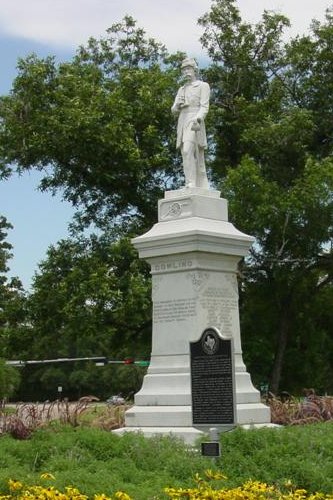War on the Texas Gulf Coast. (original) (raw)
In light of the North's vast naval superiority, one of the most remarkable feats of the American Civil War was the Texans tenacious defense of their Gulf Coast ports. From Sabine Passin the north to Brownsvillein the south, the Texans bent now and then but they refused to break. At the beginning of the war, Texas Governor Edward Clark divided Texas into 32 militia districts to better coordinate the defense of the state. Each district was commanded by a brigadier general. Brigadier General Earl Van Dorn served as the commander of the district along the Texas Gulf Coast from April to September 1861. General Van Dorn organized local defense companies, called for the use of slave labor to build coastal fortifications and did his best to procure heavy cannons to provide protection for the Gulf Coast ports.
 |
Confederate General Earl Van DornWikimedia Commons |
|---|
General Van Dorn was replaced by Brigadier Paul Octave Hebert who concluded that without sufficient heavy ordinance the Texans would be unable to prevent a Union landing along the coast. Rather than defending the coast, General Hebert felt that it was necessary to fall back and fight the enemy in the interior of the state. Therefore, he ordered the removal of most of the heavy artillery from Galveston Island, which in his opinion was indefensible. However, this strategy only served to entice the Union Navy into action. In November 1861, Federal naval forces initiated a series of harassing actions. Port Lavaca, Indianolaand Aransas Pass were shelled, and the naval blockade was tightened along the entire Texas coast. In April, a small Union flotilla attempted to capture Corpus Christi but was repulsed. A brief naval action also occurred at Sabine Pass in September 1862, but the principal Federal effort was aimed at the largest and most active seaport on the Texas coast, Galveston Island.
 |
Confederate General Paul Octave HebertWikimedia Commons |
|---|
The United States Navy began the blockade of Galveston Harbor in July 1861, but no further action was taken by the Federals until October 1862, nearly fourteen months later. Early in the morning of October 4, William B. Renshaw, commanding officer of the Union blockade, ordered the U.S.S. Harriet Lane to steam into the harbor under a flag of truce. He intended to warn Galvestonauthorities that the ships of the Union blockade would attack in one hour if the town refused to surrender, but when Confederate commander Colonel Joseph Cook ignored the demand, the Harriet Lane weighed anchor and returned to the fleet.
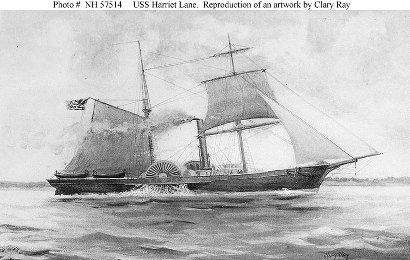
USS Harriet Lane
Wikimedia Commons
Commander Renshaw then led four Union gunboats into the harbor with a mortar boat in tow and began a heavy bombardment of the Confederate gun positions. When the Confederate guns fell silent, Renshaw demanded an unconditional surrender or he would move his bombardment to the town. The Confederates reluctantly agreed to evacuate the city, taking all their weapons, ammunition and supplies. The Union Navy now controlled the most important harbor in Texas, but the town was not fully occupied until December 25 when 264 men of the Forty-second Massachusetts Infantry arrived in Galvestonto occupy Kuhn�s Wharf and set up regular patrols.
General Hebert seemed to be more interested in enforcing martial law than defending the Texas Coast, and after the fall of Galveston, he was replaced by a new district commander, General John Bankhead Magruder. General Magruder, a Virginian with an aggressive reputation, immediately made plans for the recapture of Galveston. Two Buffalo Bayou steamboats, the Neptune and the Bayou City were converted into Confederate �cottonclads� by stacking bales of cottonon their gunwales and decks to form breastworks. The converted ships commanded by Captain Leon Smith were then manned by 300 of General Henry Hopkins Sibley�s veterans freshly returned from their trials in New Mexico, and led by Colonel Thomas Green. Two smaller ships packed with additional Confederate riflemen sailed in support of the larger vessels.
 |
Confederate General John Bankhead Magruder Wikimedia Commons |
|---|
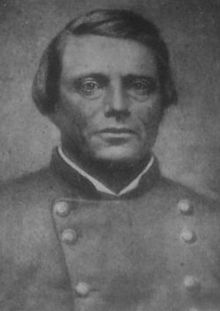 |
Confederate Colonel Thomas GreenWikimedia Commons |
|---|
General Magruder�s land forces consisted of both infantry and cavalry and were supported by twenty light and heavy cannons. He concentrated his troops at Virginia Point near the railroad bridge that connected the mainland to Galveston Island and assumed personal command on December 29. The operation was planned as a joint assault by land and sea and began at 1:00 AM on New Years Day. 1863, when General Magruder led his forces across the bridge and prepared them for a dawn assault on the city. The assault was timed to coincide with an attack on the Union ships in the harbor by the Confederate cottonclads. At dawn, the Confederate artillery opened fire on the Federal ships and the Union troop positions along the waterfront, and Magruder launched a ground assault that drove the small Federal garrison to the extreme north end of the island.
Meanwhile, the cottonclads Neptune and Bayou City steamed into the harbor and steered a course for the Federal ships that lay at anchor. The Neptune was immediately struck by a shell from the Harriet Lane, and the damaged ship veered into shallow water and sank. Undeterred, the Bayou City moved in close alongside the Harriet Lane and her makeshift marines raked the deck of the Federal ship with a deadly hail of rifle fire. The Harriet Lane struck her colors after a short but vicious firefight in which all of her officers were either killed or wounded. In the confusion, the U.S.S Westfield, flagship of the Union flotilla, ran aground on Pelican Spit. Commander Renshaw was killed in a premature explosion when the crew attempted to scuttle the flagship. Disheartened by the rout of the navy, the Federal garrison on the island surrendered.
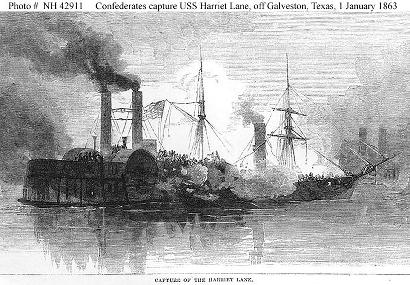
The capture of the Harriet Lane by the Bayou City
Wikimedia Commons
Although defeated at Galveston Island, the Union blockade fleet continued to maintain command of the sea along the Gulf coast and fought several skirmishes near Sabine Pass, where the Sabine and Neches Rivers flowed into the Gulf of Mexico. Based on the results of the fighting, the Union commanders in the Gulf, Admiral David Farragut and General Nathaniel Banks, conceived of a major campaign for the fall of 1863. The fleet would seize Sabine Pass and land 5000 troops who would then march overland and capture Beaumont, Houston and Galveston. General William B. Franklin was placed in overall command of the operation. The General planned to send his gunboats up the narrow channel at Sabine Pass, knock out the guns at the small Confederate fort that guarded the waterway and land his troops on the shores of Sabine Lake.
 |
Union General William Buel FranklinWikimedia Commons |
|---|
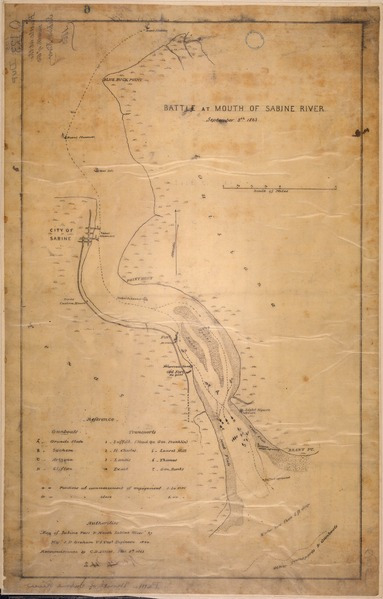
Map of the Battle of Sabine Pass
Wikimedia Commons
The Confederate earthwork fortification guarding Sabine Pass from the Union gunboats was known locally as Fort Griffin. Since neither of the senior commanders of Fort Griffin were present for the battle, the forty-two man garrison was commanded by a junior lieutenant, Richard �Dick� Dowling. Fort Griffin�s armaments consisted of two old 24-pounder smoothbores, two 32-pounders and two howitzers, but Lieutenant Dowling had trained his artillerymen well. In preparation for an attack, Dowlinghad ranged his guns to the narrowest part of the channel and trained his gunners on makeshift targets. The Confederates were ready when the Union gunboats streamed into the channel on the morning of September 8, 1863.
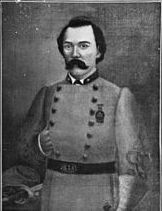 |
Confederate Lieutenant Richard DowlingWikimedia Commons |
|---|
Lieutenant Dowling remained cool, ordering his battery to hold their fire until the Union gunboats steamed within range. The Federals opened fire first, but the intense shelling did not prevent the Confederate gunners from delivering accurate return fire. Lieutenant Dowling�s guns addressed the Union gunboats one at a time as they entered the targeted area and the results were spectacular. The lead gunboat, U.S.S. Sachem, was hit in the steam drum and slowly fell out of action. Immediately turning their attention to the U.S.S. Clifton, the Confederate gunners cut her tiller rope with their accurate cannon fire, and the gunboat drifted helplessly until she ran aground under the guns of Dowling�s battery. With no choice, the captain of the Clifton raised a white flag. The remainder of the Union flotilla fled the Pass toward open water and eventually sailed back to New Orleans.
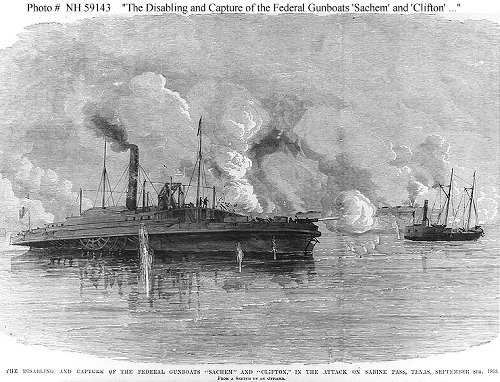
Picture of the Battle of Sabine Pass
Wikimedia Commons
Lieutenant Dowling�s battery had won the day against overwhelming odds. The Federals lost two ships, 100 dead and wounded and 350 prisoners. The Confederates remained essentially untouched. In only a few minutes, the artillerymen under Dowlinghad fought the most glorious and definitive small unit action of the war. The Federals never again attempted to force their way through Sabine Pass. After the ignominious defeat, many people in the North questioned the efficiency of their navy, and the U.S. dollar lost five percent of its value against the gold standard. By personal order of Confederate President Jefferson Davis, a special decoration for bravery was struck for the heroic defenders of Fort Griffin.
However, in spite of the Confederate victory at Sabine Pass, the Union forces at sea were much too formidable to be completely denied. Since the beginning of the war, textile manufacturers in New England had been pressuring President Lincoln to seize the Texas Gulf coast and restore the flow of cotton to the North, but the President refused to act until the Union captured Vicksburg, Mississippi. The city of Vicksburg served as the key link in the Confederate supply line between Texas and the eastern states. In July, 1863, Vicksburg surrendered, and now that the Trans-Mississippi region was cut off from the rest of the Confederacy, taking possession of the Texas cotton fields seemed like the next logical step. Lincoln was also concerned about interference from the French who had recently intervened in Mexico.
In furtherance of Lincoln�s plans, General Banks landed 6,000 troops on Brazos Island near the mouth of the Rio Grande in November 1863. After storming the island, the troops marched inland and captured Brownsville, temporarily cutting off the vital cotton trade between Texas and Mexico. The retreating Confederates set fire to the town, and the looting and violence continued for several days. After occupying Brownsville, General Banks split his forces, sending one column up the Rio Grande River to capture Rio Grande City and the other column north along the coast to capture Corpus Christi, Aransas Passand the Matagorda Peninsula. By the end of 1863, Sabine Pass and Galvestonwere the only ports on the Texas coast controlled by the Confederacy.
 |
Union General Nathaniel BanksWikimedia Commons |
|---|
Fortunately for Texas, the temporary loss of the coastal region had little adverse effect on the course of the war. The ports along the Gulf Coast were far from the population centers in east and central Texas, and even if they had been in Confederate hands the Union blockade would have prevented them from shipping or receiving any goods. However, Union control of the ports did lessen the possibility of cooperation between the Confederacy and the French that the South hoped for. General Magruder called for additional soldiers to drive the Yankees out of Southern Texas, but as the threat of French intervention slowly waned, many of General Banks� troops were transferred to Louisiana where a major offensive was planned for the spring of 1864.
Eventually every Federal garrison in south Texas was transferred except the one occupying Brownsville. The city of Brownsvillewas the key to the southern border of Texas and its possession enabled the Union to disrupt the vital cotton trade between Texas and Mexico. However, with the withdrawal of the majority of Federal troops, John �Rip� Ford�s Cavalry of the West soon recaptured most of the occupied territory. In the summer of 1864, Ford reoccupied Brownsvilleand once again opened the cotton trade with Mexico. By the end of the war, the only land on the lower Texas coast that remained in Union hands was Brazos Island.
©
Jeffery Robenalt
"A Glimpse of Texas Past" April 2, 2013 Column
jeffrobenalt@yahoo.com
References >
Related Texas Topics:
Columns| People | Texas Town List | Texas History | Texas
Books by Jeffery Robenalt - Order Here >
References for "War on the Texas Gulf Coast"
- Ashcraft, Allen Coleman, Texas, 1860-1866: The Lone Star State and the Civil War (Ph.D. dissertation, Columbia University, 1960.)
- Barr, Alwyn, �Sabine Pass, September 1863,� Texas Military History 2 (February 1962).
- Barr, Alwyn, �Battle of Galveston,� Handbook of Texas Online (http://www.tshaonline.org/handbook/online/articles/geg01), Accessed November 29, 2012.
- Buenger, Walter L., Secession and the Union in Texas (Austin: University of Texas Press, 1984)
- Cumberland, Charles C., �The Confederate Loss and Recapture of Galveston, 1862-1863,� Southwestern Historical Quarterly 51 (October 1947).
- Muir, Andrew Forrest, �Dick Dowling and the Battle of Sabine Pass,� Civil War History 4 (December 1958).
- Tolbert, Frank X., Dick Dowling at Sabine Pass (New York: McGraw-Hill, 1962).

Custom Search
Book Hotel Here- Expedia Affiliate Network
Books by Jeffery Robenalt Order Here
